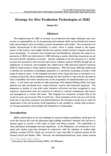Strategy for Rice Production Technologies at IRRI
JIRCAS international symposium series
| ISSN | 13406108 |
|---|---|
| 書誌レコードID(総合目録DB) | AA1100908X |

本文フルテキスト
intlsymp-6_191-202.pdf393.88 KB
The targeted areas for IRRI to increase rice production with higher efficiency and more concern on sustainability are all rice-growing environments which can be divided into several basic agroecological units according to annual temperature and rainfall. Rice ecosystems are further characterized by the availability of water, which is closely related to the toposequence of the location, and roughly divided into upland, rainfed lowland, irrigated and flood-prone ecosystems. To promote more focused and interdisciplinary research, the research organization of IRRI was restructured in 1989 following a matrix which has ecosystems on one axis and scientific discipline on another. Another emphasis in the new structure is to further promote the association with national agricultural research systems (NARS) through the establishment of consortia, and strengthen the collaboration with advanced research institutes (ARI) for rapid access to latest research developments. With this setup, IRRI has endeavored to develop rice production technologies applicable to a particular ecosystem covering a wide range of research areas. In the irrigated ecosystem, where Japan has been so successful in increasing productivity, direct seeding technology has been tackled to cope with the decrease in labor availability and water resources due to the progression of industrialization and urbanization. A new plant type suitable for this technology with reduced tillering ability and large panicles has been developed from crosses between tropical and temperate japonicas. The stagnation or decline of crop yield under intensive cultivation has been recognized in most long-term experimental sites and analyzed in relation to nutrient management and insect/pest management to reverse this trend. The irrigated rice ecosystem occupies 54 % of the world rice area and produces 75% of world rice. Since expansion of the rice area will be difficult due to the dense population and industrialization, the increase in production to meet the requirement of the ever-growing world population is only possible by raising yield productivity through germplasm improvement and integration of technologies.
| 作成者 | Osamu Ito |
|---|---|
| 公開者 | Japan International Research Center for Agricultural Sciences |
| オンライン掲載日 | |
| 号 | 6 |
| 開始ページ | 191 |
| 終了ページ | 202 |
| 言語 | eng |
